By Mari Taketa
It’s the weather that calls us back – or the surf, or the Islands’ gorgeous blues and greens, the aloha spirit, the laid-back lifestyle. The food, of course. And family. That’s always the clincher, especially in a world of unknowns and social distancing, where the need to be close to those you love is exponentially more powerful.
From Boston to San Francisco and Tokyo to Dubai, the yearning for home is a familiar one. At some point, for many, it crystallizes into a need, and the questions become real. How to find a job and housing? In a place where a 50-year-old fixer-upper sells for over $1 million, is moving back even feasible?
The equation is complicated for Punahou alumni. Reared to dream big, offer their talents to the world and fulfill their potential, the overwhelming majority leave the state for college – 92% of the Class of 2019, in fact. Many will stay away for grad school and careers in bigger cities. Many will start families and put down roots far away.
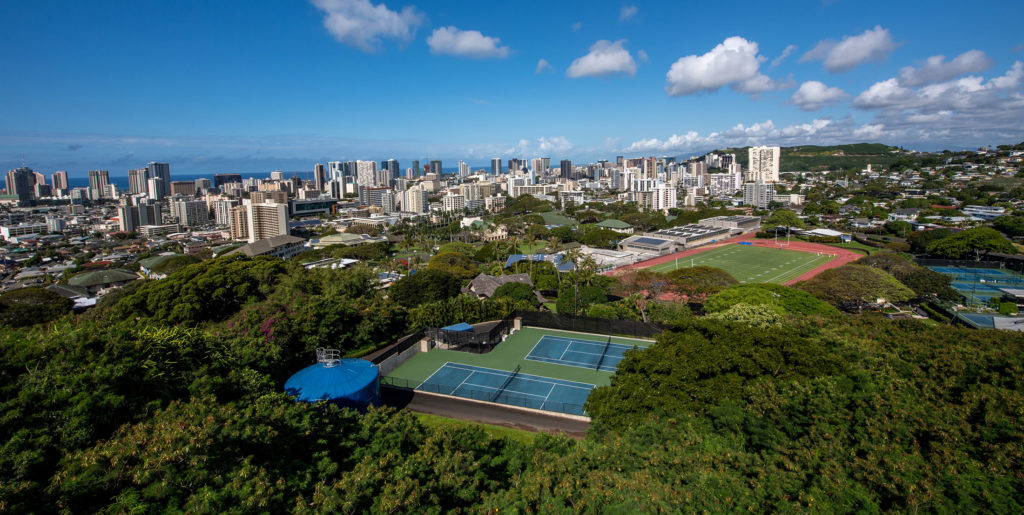
But then the calling comes. It could be external – a need to care for family members. But often, it’s something deeper pulling Hawai‘i natives back to the Islands. “We know many alumni are looking for ways to come home, whether it’s now or sometime in the future,” says Doug Rigg ’84, Punahou’s director of Alumni Relations. “Hawai‘i will always be our home, no matter how many years we’ve been away. So many of us are deeply connected to our families, friends, Punahou and Hawai‘i. At some point, we can’t help but wonder how to make our way back.”
The journey back, however, is filled with complexities considering Hawai‘i’s geographic isolation, staggering cost of living and somewhat limited career opportunities for both alumni and their spouses. When alumni decide to return, their biggest advantages are often their rich work experiences, since many have soared in their individual professions, and their well-connected Punahou network.
For Gregg Yamauchi ’04 it was a chance meeting at a Punahou pau hana that led to the job in finance that brought him home from Los Angeles. His wife, Chelsea Chun ’03, found her job as an associate attorney on Punahou Connect, a job network organized by Punahou Alumni Association (PAA). But other factors can narrow options for would-be returnees. Many want to give their children the same supportive, immersive buff ’n blue education they grew up with. For families who uproot lives to move back for this, the choice of schools is often Punahou or nothing – and when things don’t work according to plan, some end up uprooting a second time and leaving Hawai‘i again.
Punahou for Our Children
Punahou’s draw is so compelling that when kids do get accepted, there’s sometimes an extraordinary cost. Allen Murabayashi ’90, co-chair of Punahou Alumni Association’s New York chapter (PAANY), knows a venture capitalist classmate who moved his family to Hawai‘i and then, with two children accepted to Punahou, began commuting from his job in Vietnam’s emerging market. Cass Nakasone ’86 talks of his classmate, an academic at a leading West Coast university, who flies home on weekends to see her Punahou-enrolled children. “Talk about sacrifice. It’s incredible what people have done to try to get back to Punahou,” Nakasone says. “I came from public school. I came to Punahou in ninth grade. The older I get, the more I realize it’s such an incredible school.”
Others come up against a built-in irony of Punahou’s culture of success: They do so well they outgrow the Hawai‘i market. There are no companies or organizations of comparable size in their fields, or their fields don’t exist in Hawai‘i. And their big-city earnings can weirdly turn into drawbacks, since they sometimes fuel lifestyles that in Hawai‘i are reserved for the super wealthy. That means those who move back anyway have to fundamentally want to, since the cost of living is almost always higher and compensation packages are sometimes half of what they’re used to.
“It adds a layer of complexity to the equation,” says Murabayashi, a tech entrepreneur who co-founded the photography archiving platform, Photoshelter. “Ultimately, for a lot of people, the challenge is finding a similar job at a commensurate pay level back in Hawai‘i, particularly for people that have come from a tech background. We have a bunch of people working at Facebook or Google or Instagram, and there’s nothing in Hawai‘i on the scale of what they’re doing in New York or Silicon Valley. And if you’re a multimedia producer and you came from Vox or MSNBC, what job exists where you can do that type of work in Hawai‘i?”
Lured by Hawai‘i’s Quality of Life
These questions come up as Murabayashi helps organize his chapter’s Spam musubi-making event every fall and a miniaturized version of Carnival – complete with malasadas, Portuguese bean soup and other favorites – on the same February weekend in New York City. At 48, he notices more the sub-freezing temperatures and 4:30 p.m. sunsets in winter, and is keenly aware that at the same hour back home, people are leaving their offices to jog around Kapi‘o¯lani Park.
“I’ve talked to a number of alumni who have young children and very successful careers in different industries and have expressed an interest in moving back,” he says. “There’s a familiarity to Hawai‘i and a quality of life that’s difficult to find anywhere else. There isn’t this (mentality of) we have to work constantly. People are willing to stop work at 5 or surf dawn patrol. You just don’t have that opportunity in New York or many other places. When you get to people who are my age, some of my classmates say my parents need me to be there, or simply I want to be with my folks in the last decade or two of their life.”
In Washington, D.C., where Lilian Yip ’92 Yang co-chairs the PAA Mid-Atlantic chapter, transitioning home is a frequent topic at speaker panels. Like New York, the D.C. area is a magnet for high achievers, and Yang sees similar patterns of alumni moving home at different stages of their careers. Yang is in the category of expats who worry about aging parents. It’s a topic she’s been talking about with her best friend from Punahou, an attorney in Ohio whose widowed mother is in her 80s. Yang’s friend is an only child, but with her own children in primary and middle school in Columbus, a move to Hawai‘i is not an option. Nor is it for Yang, a senior branch administrator at the National Institutes of Health, whose husband holds a high-level job at the Department of Justice. She’s grateful that her sister, Angela Yip ’96 King, lives in Honolulu near their parents. “It’s always on the top of mind for folks from Hawai‘i – that it would be nice if I could move back,” Yang says. “But then there’s the reality that sets in because it doesn’t make sense.”
Things are more fluid on the West Coast, where two and three-hour time differences and relatively short transpacific flights make coming home less of an ordeal than an 11-hour direct from JFK to Honolulu. It’s also the case that many graduates who head to college in Los Angeles, San Francisco, Portland and Seattle know from the outset they’ll return to Hawai‘i eventually. So it’s not surprising that in the Bay Area, the topic of the panel discussion Steve Marzo ’07 is organizing for PAA Northern California is tips for moving back to Hawai‘i.
Everyone’s Having the Conversation
The path home may be more obvious for doctors and commercial real estate investment specialists; not so much for those in finance or biotech. “This is definitely a conversation you have at every Punahou alumni event,” Marzo says. “I’ve talked to a fair amount of folks who would like to move back to Hawai‘i and start their own business, but have no idea where to start. There’s definitely a knowledge gap.”
So how do Punahou graduates find their way home? How do they make it work? And how can they make it easier for the next generation of kids who will grow up, move away and yearn to come home?
The Recruiter

Distance between Hawai‘i and the far-flung places alumni end up in isn’t measured only in miles. There’s time – the years since graduation that have changed the landscape of living, working and raising children in the Islands. And there are social connections that wear thin and disappear as people create lives in new places.
Few know more about this than Tahnee Allman ’08 Towill. The founder of local boutique firm HIVE Recruiting, she’s a C-suite specialist who gets frequent inquiries from expat kama‘āina who want to come home. “The Hawai‘i market is always looking for talented people, especially with a connection to the Islands. A lot of employers here are a little bit reluctant to relocate candidates from the mainland if they don’t have really strong Hawai‘i ties,” she says. “With the environment of the job market, companies are really looking for Punahou graduates that have experience on the mainland and want to come back.”
Tips for the Transition
NO.1
S T A Y R E L E V A N T
Use your Punahou connections to stay in touch. Sign up for alumni events on the mainland. Check out Punahou happenings during visits home, volunteer at a local nonprofit, or even ask about joining its board of directors. That way you’re still constantly thinking about the community – how you can add value and what you can bring back. The key is to always stay connected to Hawai‘i.
NO.2
S T A R T E A R L Y
On visits home, schedule two or three meetings with professionals who are above you in your career field. If you’re a mid-level insurance manager, call or email the CEO of an insurance company in Hawai‘i who is a Punahou graduate. If there isn’t one, look at the rest of the executive team. Is there anyone who’s a graduate? The answer is most likely, “yes.” Ask if they have time for coffee and prepare key questions: How have they seen people transition smoothly from the mainland? What opportunities do they see coming up in the next year? You already have something in common. The Punahou connection is so strong; everyone says, “yes.”
NO.3
S T A Y U P T O D A T E
Subscribe to job boards and newsletters of leading companies in your industry. Don’t overlook LinkedIn – it’s an important tool and a good way to reach out to fellow alumni. Keep your profile updated and get your current resume on one page. Towill says hiring a professional resume writer is a good idea.
The Returnees
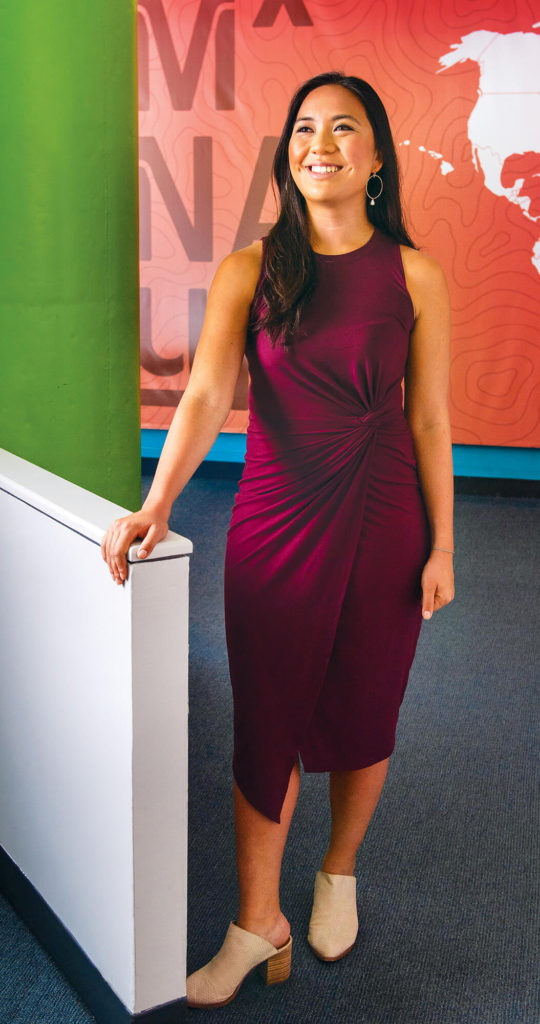
HER ADVICE: “It’s a really difficult decision to make. My mainland friends, and even my family, could not understand the inner debate and turmoil. They thought it was as simple as, ‘Well if you want to, you should. And if you don’t, you shouldn’t.’ I think it’s up to you to establish your needs, then to be realistic and honest with your options. I ultimately found myself realizing – over time – ‘Okay, I would need to sacrifice X, Y and Z, which is important to me. But I would also gain A, B, and C, and that’s worth it to me.’ Your conclusion may be different than mine, but you need to take the time to understand that.”
C O L B Y S A M E S H I M A ’ 1 2
Colby Sameshima’s ’12 trajectory home started out straightforward enough. She headed off to Tufts University knowing she would come back – but then her interest in earth science and climate change morphed into a job supporting entrepreneurs in emerging markets. First from her company’s New York headquarters, then from its San Francisco satellite office, she found herself flying to Cape Town, Buenos Aires, Kuala Lumpur and Dubai to help local startups with global scaling challenges. While based in San Francisco, her mother got sick, trips home to Honolulu became more common and the yearning came back. “In California, I could have some of both worlds, Hawai‘i and mainland-East Coast mentalities,” she says. “But eventually, I began to see that what’s most important to me is ultimately being close to my family, giving back to this place that completely shaped who I am, and being able to raise kids in this culture. I realized I should probably start to make moves toward that decision.”
Sameshima’s research into the entrepreneurial ecosystem in Hawai‘i turned up a few new accelerators, including Mana Up, an accelerator that aims to take locally headquartered companies global. Co-founder Meli James ’96 was a Punahou graduate. Sameshima couldn’t believe it when James – named as one of Entrepreneur magazine’s Women to Watch and entrepreneurial disruptors – was slotted to speak at a Bay Area event a few months later. She asked for a chat over a cup of coffee before the event, and the two hit it off.
Then on a visit home for her grandmother’s 90th birthday that summer, she watched entrepreneurs at Mana Up’s annual showcase pitch their stories and products, and realized that while she had seen the same thing all over the world, this time her local connection made the scene resonate tenfold. That clinched it. When James offered to create a position for her, Sameshima felt as if the universe was telling her to come home.
Now 26 and Mana Up’s portfolio manager, Sameshima works on long-term growth for its entrepreneur partners and the bigger local economy. She lives at home and maintains a long-distance relationship with her boyfriend in the Bay Area. “For us from Hawai‘i, it’s especially difficult to navigate life (on the mainland) because we have such a unique culture. When you transition back, you do so with a different identity – hybrid local-mainland,” she says. “It hasn’t been completely seamless to adjust. You get used to having access to so many concerts, musicals and meeting people from everywhere (in San Francisco/New York). But it has also been so wonderful. I hike and jump in the ocean every week, and see my favorite aunties and uncles at my favorite local spots.
“I would argue all of this made me appreciate Hawai‘i even more. The whole time I was like, I still prefer Honolulu. It’s the best place on earth. I began to sense even more so this was the right place for me. For now.”
R O M I B E P P U ’9 4
En pointe, graceful arms sweeping toward her prince, she is the Sleeping Beauty. Pirouettes and leaps, her joy and torment arcing across the stage before enraptured audiences, she is Giselle. Romi Beppu ’94 knows how it feels to live the dream. What she didn’t know, dancing across the world with American Ballet Theatre, Boston Ballet and Ballet West, was that even a calling so rarefied and powerful could be a segue to a bigger one – awakening the dream in young dancers back home.
For a good while, there was only one direction – onward and up. It took Beppu from Honolulu to summer training in New York, where she discovered the horizons of worldclass ballet. It was at Boston Ballet where she made principal ballerina. From then on, anywhere she went, she would command that title.
Beppu had arrived from the farthest reaches of the country. If it hadn’t been for her parents, who let her spend summers with a relative in New York, she would never have known a life in ballet was possible. When teaching ignited a new passion, she continued to nurture it, teaching and dancing at Boston Ballet, and later, at Utah’s new Ballet West, where she danced for half the year and taught students on O‘ahu and Maui the other half. In 2012, Beppu moved home and opened her studio, Honolulu Classical Ballet in Kaimukī.
When Beppu was injured late in her career – just shy of turning 30 – months of being sidelined steered her into teaching as a way to stay motivated. “My injury was a tougher time in my life. Something you really love is taken away from you, but it was a blessing in disguise in so many ways,” she says. “Dancing or anything elite like the Olympics – it’s really about you. There’s teamwork, but there’s so much focus on yourself. On the teaching side, it’s about giving back. That was really meaningful at that point in my life, because so much had been given to me. I came to the realization of, now, what do you do with it?”
“It’s not a lack of high-level coaching – there are a lot of great teachers on the Island,” she says. “I could have worked in Boston. I could have worked in Utah. But I felt like when I was growing up here, this was a dream of mine. I felt like by coming back I could try to help students if they wanted a professional career. I had access to contacts I had met nationally and internationally, because I was one of them years ago. This was the right move for me, because there’s a significant impact to what I’m doing. It doesn’t have to reach 5,000 kids. If it reaches just a handful, that’s meaningful to me. I feel like I’m giving back to the community that supported me.”
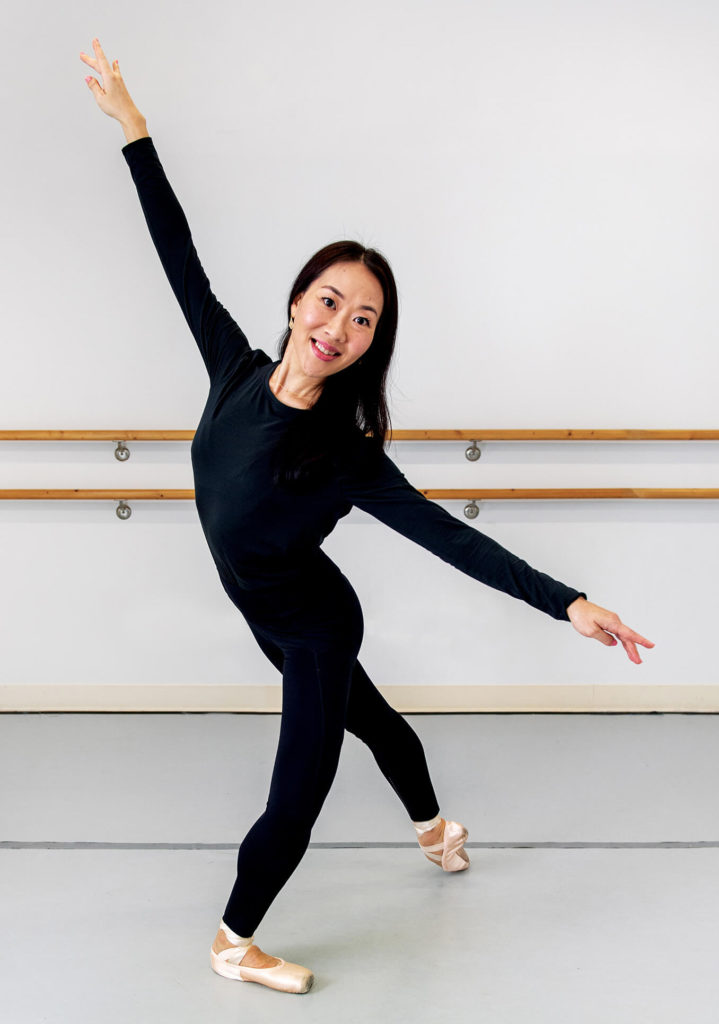
HER ADVICE: “You have to be willing to sacrifice a little bit … but also remember how you were supported as a young student in your career – how much you have achieved on the mainland, and then think about the next generation of kids who need that mentoring in whatever career path they’re interested in.”
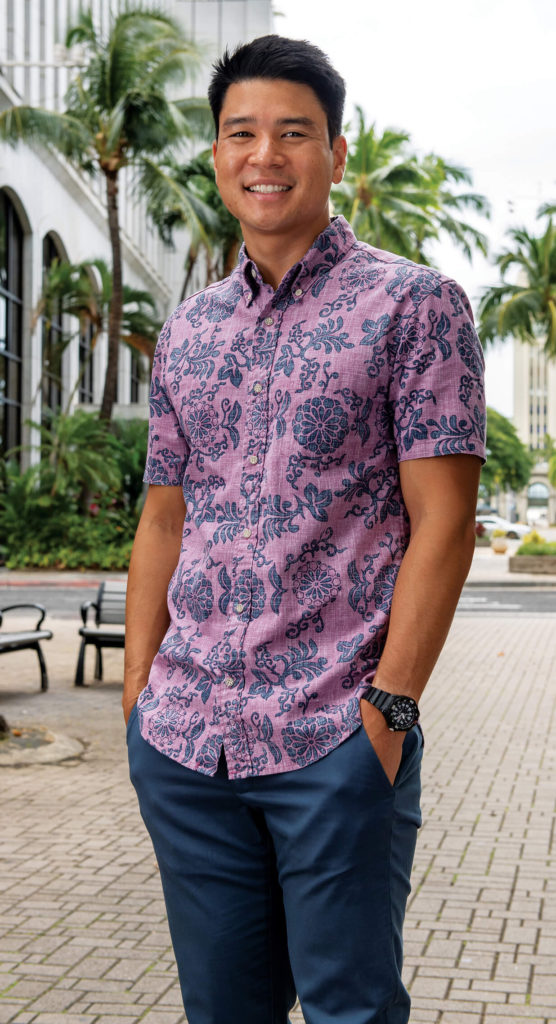
G R E G G YA M AU C H I ’ 0 4
If you want a textbook example of how to leverage Punahou connections and overseas experience for a smooth path back to the Islands, look at Gregg Yamauchi ’04. Yamauchi is a walking how-to: He studied business at USC, focusing on commercial real estate, not just because he was interested, but because it seemed like a potential way home. Years later, he had just returned to Los Angeles from a long stint in London, where he’d set up the European division of an L.A. private investment fund, when he organized a young professionals mixer on a visit home. It was something he did regularly – seek out new professional contacts, sit down for coffee and find out the latest in the Hawai‘i market. Also at the pau hana looking for contacts was Harrison “Jeeter” Ishida ’08, a VP at Trinity Investments. “If you ever think about moving home … ,” Ishida said.
HIS ADVICE: “Make sure you’re staying in front of people and keeping in touch with what’s going on here in the Islands. Get involved with Punahou Alumni Association. When you think you’re ready, make sure you’re in the right spot and ready to move back from a lifestyle perspective. Salaries (in Hawai‘i) aren’t as good, but that’s also an opportunity to create a job or position for yourself that maybe didn’t even exist here.”
Yamauchi never forgot the open-ended invite that spoke directly to one of his life’s goals. A year or two later, he was newly married to Chelsea Chun ’03. She quickly found an associate attorney position through the Punahou Connect job platform and moved back to Honolulu first. Yamauchi reconnected with Ishida, and in 2017, moved home to join Trinity, where he’s now VP in charge of acquisitions. That Trinity had real estate dealings as far away as Japan and Mexico allayed Yamauchi’s worry that he was leaving a global playing field for a much smaller market. But scaling down their personal lives from the headiness of Los Angeles, where major sports events and A-list concerts were the norm, and San Francisco and Palm Springs were within driving distance. How much would they miss it? “Now that we’re home and we’re settled and we have a family, it works for us. The life here is different – less exciting. But it’s just nice. What I like to do for fun now is surfing and spending time with my kid, taking her to the beach, out to the park,” Yamauchi says. “It was all pretty smooth, to be honest. We love our life here. It’s been great to be back.”
C E L E S T E C O N N O R S ’ 9 4
For Celeste Connors ’94 the choice was between Kailua and London. One was her hometown, the other her retired British diplomat husband’s, and for a Beltway couple wanting to raise their children closer to family, the choice was far from obvious.
When they weighed the astronomical costs of both cities against the lifestyle each afforded, in some ways London with its world-class everything came out ahead. Then Connors’ father in Kailua got sick, and the decision was easy. As it turns out, Hawai‘i Green Growth, a public-private leadership group working to advance economic, social and environmental goals, was looking for its first executive director and reached out to Connors via Punahou Connect.
It seemed almost destined: Connors had built a career as a diplomat specializing in international sustainability, climate and foreign policy. She’d worked at the highest levels of climate change policy in the Obama White House, put in years abroad at U.S. embassies and served on the U.S. Mission to the United Nations. At one point, she helped negotiate an international climate treaty.
Clearly Hawai‘i Green Growth had chosen her to level up its work – to get it onto the world stage and connect it with like-minded initiatives for maximum collaborative impact. The specifics were up to her. “The international community is looking for scalable solutions to achieve the global sustainability goals, and has turned to Hawai‘i for inspiration,” she says. “Sustainability is about systems thinking across economic, social and environmental sectors. Growing up on an island, kids from Hawai‘i inherently understand that what happens in the watershed will affect our coral reef and the communities in between. They are therefore uniquely equipped to lead the kind of policy innovation we need at this critical time.”
For Connors, it is immensely satisfying that her children, James ’27 and Elizabeth ’30, are growing up in multicultural Hawai‘i, steeped in the values of aloha, ‘ohana, kuleana and ma¯lama – that they can climb trees and play at the beach and hike Maunawili the way Connors did growing up.
As for Connors, her superpower is her command of global diplomacy. She knows how to put Hawai‘i and Hawai‘i Green Growth’s work before the eyes of the world. When she did that, the United Nations invited the organization to work with it toward global sustainability as the only Local2030 sustainability hub in North America and the Asia-Pacific.
“We’ve now had requests to share our model – Hawai‘i’s model – with communities across the world, from Tasmania and the Canary Islands to Guam and Aruba in a locally and culturally appropriate way,” she says. “I feel grateful that my professional experience and personal background growing up in Hawai‘i have converged. It took coming home after being away for many years to reaffirm what I probably always felt – that Hawai‘i’s Island culture, people and community could be a starlight for other communities and countries seeking to get on a more sustainable pathway.”
Connors says her focus now is on establishing the Local2030 Hub, building on Hawai‘i’s history of systems thinking, and attracting alumni considering returning home, as well as future graduates from across the State who are interested in careers in sustainable development and policy.
“The world of multilateral engagement is changing, and Hawai‘i and local communities can help drive high-level diplomacy, policy and action,” she says. “By sharing Hawai‘i’s sustainability framework with the world, we can attract new resources to help us achieve our goals locally, create leadership pathways for our keiki and mitigate the worst impact of climate change on our community.”
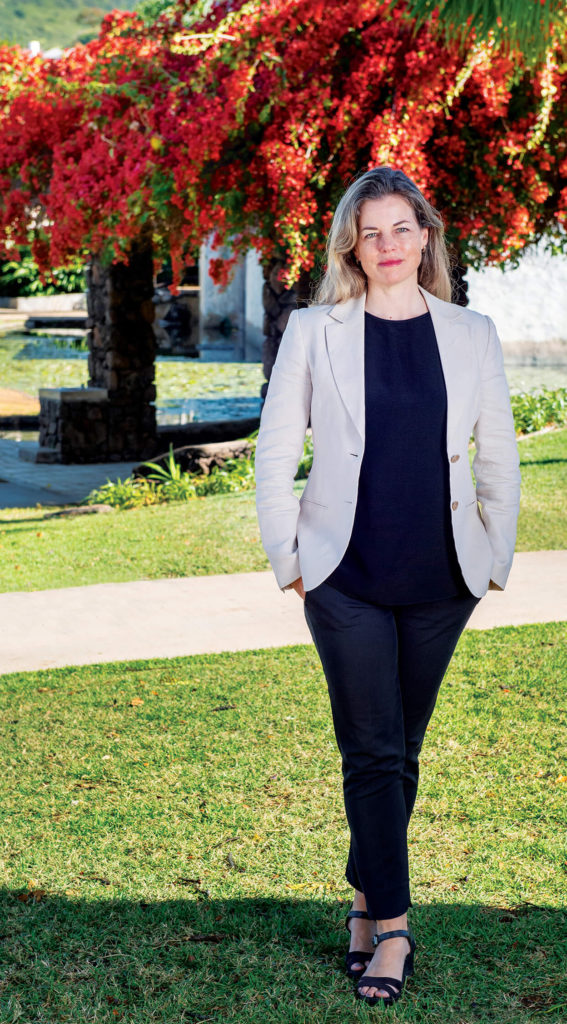
HER ADVICE: “Hawai‘i – with its incredible ecosystem of institutions and culture – is uniquely positioned to help the world navigate towards a better future. What we do here is relevant. What you can do here is relevant and presents a tangible opportunity to leverage your experience, if you are willing to be a bit innovative.”
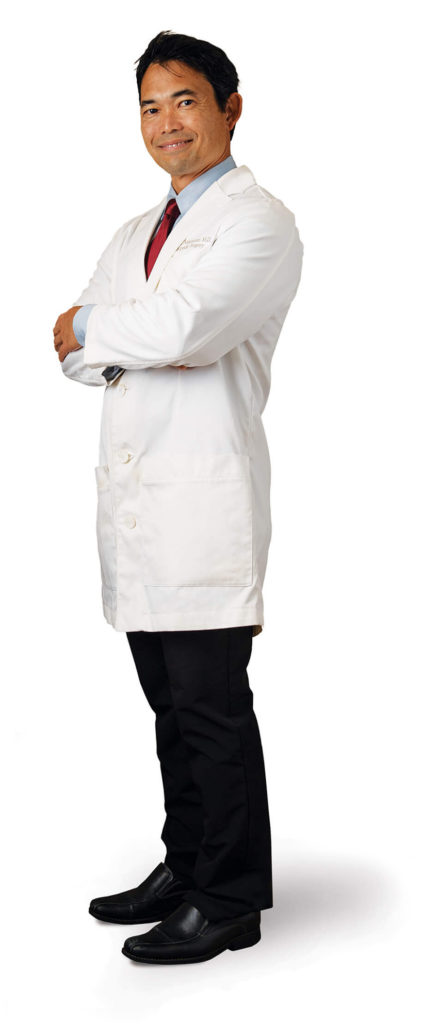
C A S S N A K A S O N E ’ 8 6
It’s not uncommon for Cass Nakasone ’86 to lecture in Japan about his methods for outpatient joint surgery. He hosts surgeons who fly across the Pacific to watch him operate at Straub Medical Center. He also teaches orthopedics at the John A. Burns School of Medicine, has published nine papers a year in medical journals and co-designed a hip implant used in several countries. Now he’s collaborating on designs for a partial knee replacement system and a sensor for hip replacement implants. Techniques he developed let him do up to 12 surgeries a day. His stature is such that few in local medical circles talk about knee or hip replacement without mentioning his name.
HIS ADVICE: “Excellence in whatever field you enter is something you should strive for. If you’re not a good doctor, it’s going to be hard for you. if you’re an excellent doctor, it’s going to be easy. You’re going to be successful anywhere.”
That’s not to say there hasn’t been a cost. “I seriously could be making more money on the mainland,” he says, half-jokingly. “I just went to my colleague’s house in Colorado, and I almost wish I didn’t see it. It looks like a hotel. He does about the same volume I do. I told him if you visit me, don’t expect the same accommodations.”
Nakasone has no regrets. Through engineering studies at Whitman College, Caltech and Stanford, a medical degree from the University of Hawai‘i and subspecialty training at the University of Southern California, he never questioned whether Hawai‘i would be his home. He wanted his children (Cole ’20 and Nicole ’23) to grow up close to their grandparents, as he had. So did his wife, Tina Unebasami ’87. At the end of all his training, Nakasone joined Straub and started putting his ideas to work.
Direct anterior hip replacements were pioneering in the Islands in 2005. Now, he says, they’re the norm. But his goal went beyond evolving his field – it was to earn for subspecialty orthopedic surgery in Hawai‘i the broad recognition he felt it deserved. It stung every time doctors at mainland conferences asked about his beach time or whether he practiced rural medicine.
“If you want to be considered a leader in your field, chances are better if you stay on the mainland and become faculty at USC or Stanford or wherever, which many Punahou graduates are,” he says. “Developing here the kinds of research opportunities they have will let students see that we can build this in Hawai‘i, and we can put Hawai‘i on the map in terms of being recognized for the high level of medical care that we’ve developed in many different specialties. I have three former Punahou students right now doing research with me and many others that have done research with us and published peer-reviewed articles.
“I have a goal of providing some kind of legacy for upcoming medical students who are all very hungry and motivated for research opportunities like this. I’m hoping they can go away and train, and somehow, we get them to come back to Hawai‘i. Because one day, I’m going to be old. I’m hoping there will be somebody who’s going to be an expert in whatever I need so I don’t have to fly to the mainland for treatment.”
The Visionaries
Runaway housing costs, eye-popping living expenses and a dearth of high-caliber jobs: Yes, it’s difficult, but the story doesn’t end there. Hawai‘i is rich in visionaries working to shift the tide, many of them on Punahou’s Board of Trustees.
Here’s what two of them have to say about opportunities for alumni at home.

M A R K F U K U N A G A ’ 7 4
Punahou Trustee (Board Chair), Chairman and CEO of Servco
Hawai‘i itself has changed a lot. It’s much more integrated into the United States and world economies. Half of Servco’s automotive business is in Australia. On our investment side, we own Fender Guitar company in California. I think this is interesting. It provides growth opportunities for folks.
Servco has an internship program with 16 interns this year from colleges across the United States and Hawai‘i and some high schools. We had over 1,300 applicants. The most gratifying thing about it is that, last year, we had several folks who were born and raised in Hawai‘i who had gone away to school.
Two or three of them were doing digital, constructing apps in human resources and marketing. They said, “I had no idea a company like Servco was doing this kind of stuff. It’s changed how I think about my career. I’m now thinking about coming back to Hawai‘i, and before last summer, I wasn’t.” So I think there are opportunities for people who want to do things along those lines here. But you have to look for them.
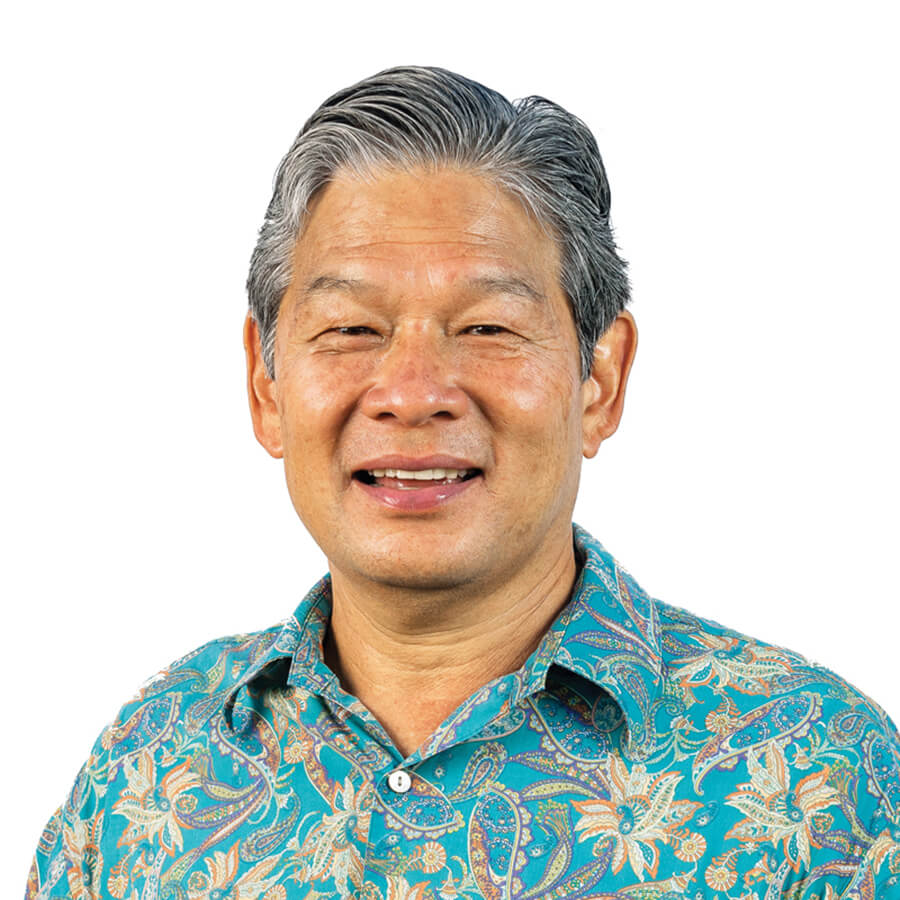
D U A N E K U R I S U
Punahou Trustee, Chairman and Founder of aio Group, Chairman of Hawai‘i Executive Collaborative
It’s become increasingly more expensive to live in Hawai‘i. It’s not only making it difficult for people who grew up in Hawai‘i to move back, but it has also been the primary reason why young people have been moving away to places that are more affordable, and where higher-paying job opportunities are more in line with the cost of housing. The recent ALICE (Asset Limited, Income Constrained, Employed) report commissioned by Aloha United Way showed that about half of Hawai‘i residents are financially insecure.
That and for reasons beyond affordability and childcare is why the Hawai‘i Executive Collaborative was formed. The collaborative is a commitment by business CEOs and government, labor, education and community leaders to tackle the most pressing issues facing Hawai‘i and seek opportunities to build Hawai‘i’s economy. Time is not our friend, so we are not seeking incremental changes, but changes that move the dial.
Today, there is a greater call for collaboration, a greater need to build an environment that accepts risks for innovation and out-of-the-box thinking, and a need to attract and congregate world-class minds and investment. The beauty is that many things have not changed – our values of family, friendship, respect, empathy and authenticity.
Come home. We need you and your children to join hands with us and help build a better Hawai‘i.
Ways to Connect
Punahou Alumni Association
paa@punahou.edu
Facebook, Instagram, Twitter,
LinkedIn
Punahou Connect (job board): Visit connect.punahou.edu
PAA Hawai‘i (PAAHI)
Includes all Hawaiian islands
President: Malcolm Leong ’88
PAA Japan (PAAJP)
Includes all of Japan
Email: paajp@punahou.edu
Co-chairs: Kei Ando ’93, Reid Matsumoto ’93,
Yugo Yamamoto ’92
Facebook
PAA Mid-Atlantic (PAAMA)
Includes Delaware, Maryland, Pennsylvania, Virginia, West Virginia and Washington, D.C.
paama@punahou.edu
Co-presidents: Les Baer ’67, Jeanette Kennedy ’93,
Lilian Yip ’92 Yang
Facebook
PAA New England (PAANE)
Includes Maine, Massachusetts, New Hampshire,
Rhode Island and Vermont
paane@punahou.edu
President: Kathleen Hanson ’91
Facebook
PAA New York (PAANY)
Includes the Tri-state area: Connecticut,
New Jersey and New York
paany@punahou.edu
Co-chairs: Maile Dyer ’08, Allen Murabayashi ’90,
Michelle Yoshida ’08
Facebook
PAA Northern California (PAANC)
Includes all California communities
north of Santa Barbara
paanc@punahou.edu
Co-chairs: Lynne Baer ’64, Steve Marzo ’07 (incoming),
Mike Ratiani ’75
Facebook
PAA Northwest (PAANW)
Includes Oregon and Washington
paanw@punahou.edu
Co-chairs: Bleu Blakslee ’87, Audrey Fan ’82,
Laura Genoves ’84, Travis Dos Santos-Tam ’09
Facebook
PAA Southern California (PAASC)
Includes all California communities south of,
and including, Santa Barbara
paasc@punahou.edu
President: Tammy Funasaki ’00, Jane Galluzzi ’08 (incoming),
Devi Ohira ’09
Facebook

